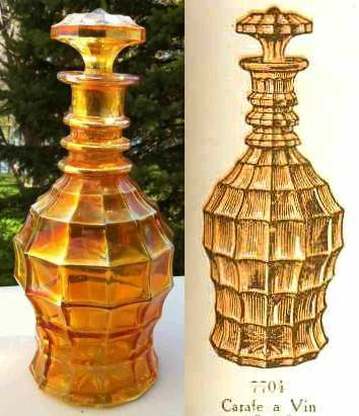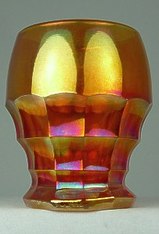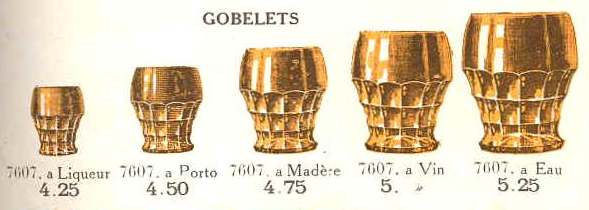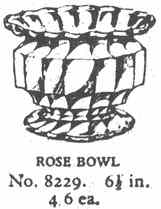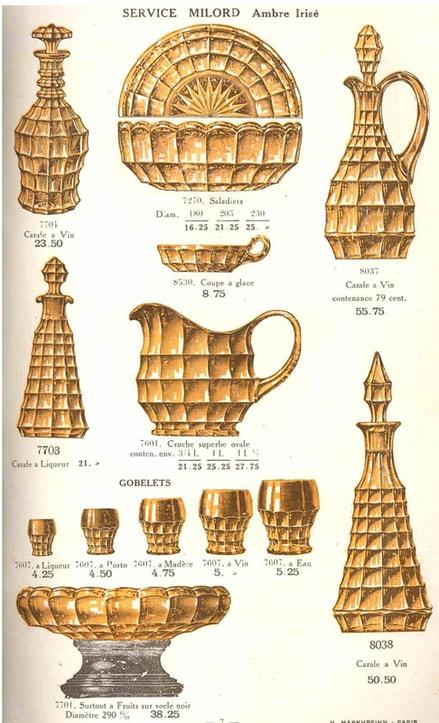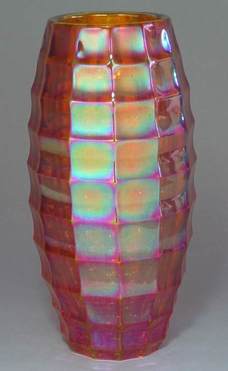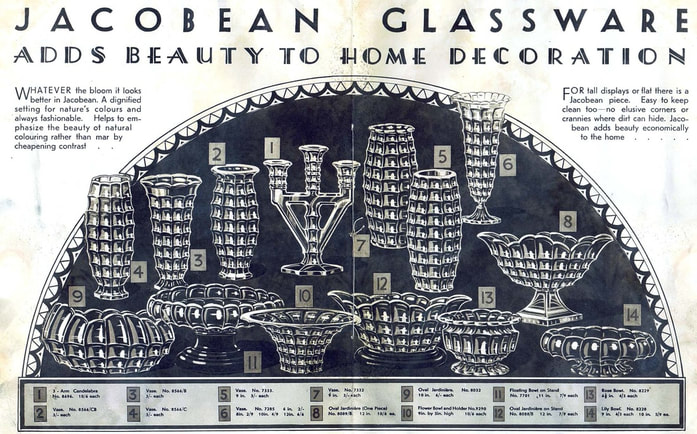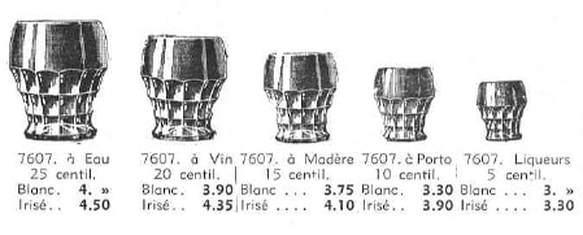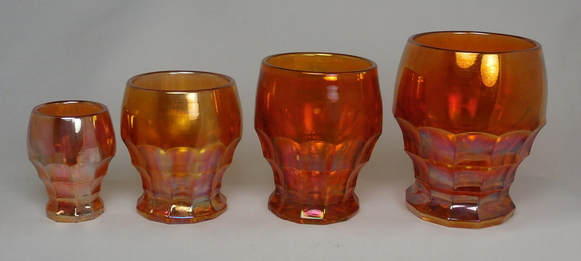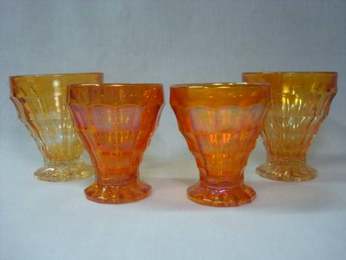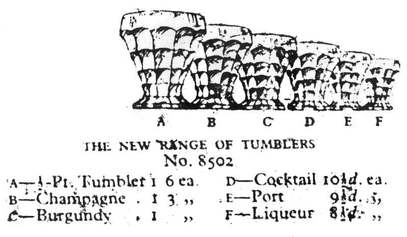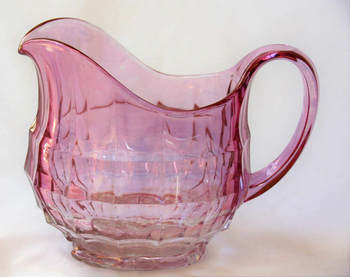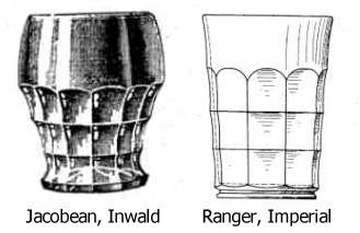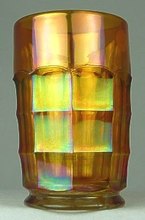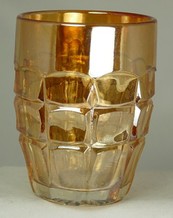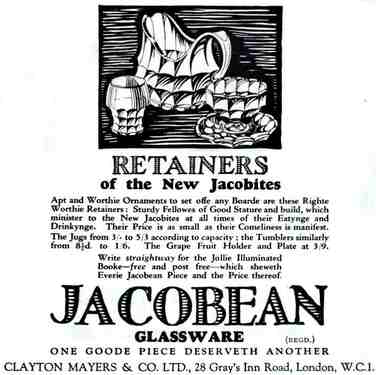Collectors Facts - Jacobean (aka Lord, aka Milord), Josef Inwald
|
Shapes:
Many! See below.
|
Colours:
Marigold, Azurit Irisé (rare)
|
|
The pattern, variously named “Lord”, “Milord” and “Jacobean”, was made by Josef Inwald of Czechoslovakia from 1921 onwards. It was widely marketed in the UK, where the name Jacobean was given to it by Clayton Mayers, the wholesaler, who also registered the design in the UK.
It was designed for an astonishing range of around 300 shapes by Rudolf Schrotter, and about 20 or so are currently known in Carnival. The pattern was cleverly adapted to so many different (and often very graceful) shapes. Shapes known in marigold Carnival include water pitcher, wine carafe, decanter, tumble-up, full dressing table set including powder jars, perfume, atomiser and cologne bottles in various sizes, a large tray, small pintray and a ring tree. Bowls are also known (including the wide “float” bowl shape). Jacobean tumblers or "gobelets" are very collectible. They were made in five different sizes, from a diminutive liqueur size up to a fairly chunky water. These are shown and explained in more detail below. A rose bowl shape not previously known in Carnival has also been spotted in rich marigold. The shape was listed as number 8229 in a Clayton Mayers’ catalogue of Jacobean items, and they called it a Rose Bowl - see below.
Note the pinched in and flared cuspidor style top – wouldn’t it be lovely filled with roses? Jacobean was a hugely popular pattern, and after around 1932 (and a change in import tariffs) many Jacobean moulds were sent to the UK where they were worked by Davidson, being made extensively in clear glass, (crystal) but not in Carnival. However, all the Carnival production was made by Inwald. |
There are two shapes of a nine inch cylinder vase; one has a straight top, as shown below, courtesy of Joan Doty, and one where the top has been pinched-in and flared (spittoon shaped). Both shapes can be seen in the circa 1930 Clayton Mayers brochure, also shown below.
Jacobean Tumblers
Inwald made five different sizes of what were called “gobelets” (number 7607) in the Markhbeinn catalogue of Inwald’s glass, as shown below.
In the photo below left, we show four of the sizes - the Liqueur, Madeira, Wine and Water. The size not shown in the photo is the Port, which in size, would come between the Liqueur and the Madeira. All the four shown in the photo have have a moulded Registered Design number on them, which is moulded into the glass on the bottom outside rim - Regd. No 702446.
Inwald made five different sizes of what were called “gobelets” (number 7607) in the Markhbeinn catalogue of Inwald’s glass, as shown below.
In the photo below left, we show four of the sizes - the Liqueur, Madeira, Wine and Water. The size not shown in the photo is the Port, which in size, would come between the Liqueur and the Madeira. All the four shown in the photo have have a moulded Registered Design number on them, which is moulded into the glass on the bottom outside rim - Regd. No 702446.
|
The number was registered in the UK by the agent Clayton Mayers on 17th December, 1923 – two years after the Jacobean pattern was first launched by Inwald in 1921. As an interesting aside, the number 6 appears backwards on the smallest of the tumblers (the little liqueur glass) - a mistake made by the mouldmaker that was most likely not spotted due to its very small size. We were able to match the five catalogue sizes to the four that we have, by means of the liquid capacity. In a 1935 catalogue we found the tumblers listed with their metric capacity in centilitres. We experimented with our four sizes of tumbler and were thus able to determine which of the sizes we had. |
Five different sizes of "gobelets" as shown in the Markhbeinn catalogue of Inwald's glass
|
Four of the five known sizes: from left to right - Liqueur, Madeira, Wine and Water.
The Five Sizes are:
|
Liqueur ("Liqueurs")
2¼ inches high (5.8cm) Base is around 1⅛ inches across. It is smoothly ground and has an incised 10 point star. 50 ml. capacity (5 centilitres) Water ("Eau") 3⅝ inches high (just under 9.5cm) Base is just over 2¼ inches across. It is smoothly ground and has an incised 12 point star. 250 ml. capacity (25 centilitres) |
Port ("Porto")
Unknown height and base size 100 ml. capacity (10 centilitres) Wine ("Vin") 3⅛ inches high (8cm) Base is 1⅞ inches across. It is smoothly ground and has an incised 12 point star. 200 ml. capacity (20 centilitres) |
Madeira ("Madère")
2¾ inches high (7cm) Base is 1¾ inches across. It has a smoothly ground base and has an incised 12 point star. 150 ml. capacity (15 centilitres) |
UPDATE - New tumbler shape found
Made in Czechoslovakia, and found in .... South America. This find and the picture comes to us courtesy of Cláudio Deveikis. We are familiar with the "gobelets" shaped tumblers (see above), but this shape in the Jacobean pattern, below, was entirely new to us in Carnival.
Research through our catalogue material revealed this Clayton Mayers ad from 1934, (below right) announcing "the new range of tumblers". Mystery solved!
Made in Czechoslovakia, and found in .... South America. This find and the picture comes to us courtesy of Cláudio Deveikis. We are familiar with the "gobelets" shaped tumblers (see above), but this shape in the Jacobean pattern, below, was entirely new to us in Carnival.
Research through our catalogue material revealed this Clayton Mayers ad from 1934, (below right) announcing "the new range of tumblers". Mystery solved!
|
UPDATE #2 - Rare colour discovered.
We have reported previously - in Eureka Inwald! - about rare Carnival colours made by Inwald - a pale delicate blue, that they referred to as Azurit Irisé, and a pinkish-amethyst. On the right is an example of Jacobean in this pinkish-amethyst colour. Found in Paris, this pitcher is a rare item of Inwald's Jacobean. |
Jacobean "look-alikes"
It's not surprising that Inwald’s Jacobean had many followers and subsequent look-alikes, including the slightly later Ranger pattern made in the USA by Imperial Glass (compared below), and Toffee Block, possibly made by Rindskopf, Czechoslovakia.
It's not surprising that Inwald’s Jacobean had many followers and subsequent look-alikes, including the slightly later Ranger pattern made in the USA by Imperial Glass (compared below), and Toffee Block, possibly made by Rindskopf, Czechoslovakia.
|
The Clayton Mayers advert on the right is from 1929.
Despite the splendid "olde Englishe" language being used in the advert, it was purely a marketing ploy to give the impression that it was made in England! At that time, the glassware was still being made in, and imported from Czechoslovakia at that time. It was only later, after 1932, was some of the Jacobean pattern made by Davidson in north-east England - and Davidson did not make any Jacobean in Carnival. |
See more Collectors Facts
